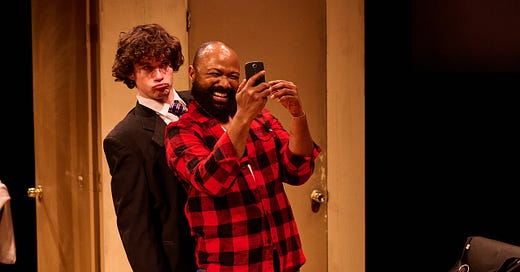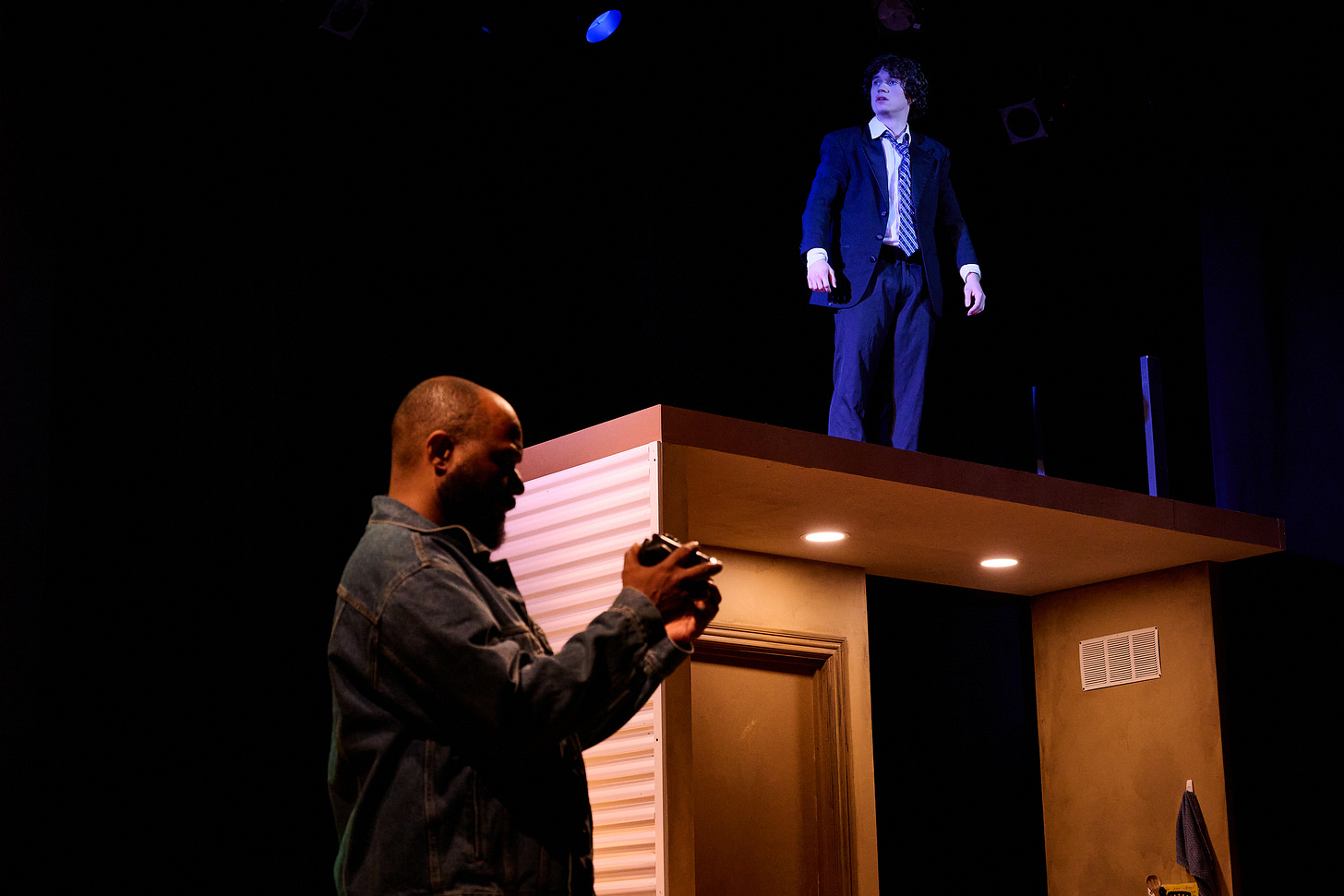More to monsters than meets the eye in "Monsters of the American Cinema"
Terror and skepticism give way to compassion and hope in Pandora Productions' latest offering.
Monster flicks from Hollywood’s Golden Age place characters into one of two categories: monster or innocent. In these movies, evil becomes obvious through ugliness. Creatures emerge or an unlucky stranger transforms into something deranged through a painful and gruesome process. The moral compass in these movies is often as black and white as the pictures themselves.
Aurion Johnson and Ian Cobb in Pandora Productions’ “Monsters of the American Cinema.” Photo courtesy of Pandora Productions.
“Monsters of the American Cinema” juxtaposes these horror classics with a modern horror story. The play at Pandora Productions runs through Oct. 27. This story is much more nuanced and complex than is found in a 1930s cinema library. Absent parents, addiction, secrets, and racial politics replace vampires, werewolves, Frankenstein and invisible men. The monsters in the movies often lack humanity, but real-life monsters have their own lived traumas. Through nonlinear storytelling using duologues, split scenes and dream sequences, “Monsters of the American Cinema” digs deep to ask, “What makes a monster?”
Remy (Aurion Johnson), a black widower, and his deceased husband’s son, Pup (Ian Cobb), a white 16-year-old boy carry the story. After Pup’s father’s passing Remy assumes parental responsibilities for Pup, and ownership over the family business, a drive-in movie theater specializing in the classics. The two share a mobile home on the property and a bond rooted in the grief of losing a partner and parent. But it becomes clear that their lives reach farther than just the mobile home. Remy can’t sit in the sorrow of losing his spouse forever, and Pup sees his male friends who use racial and homophobic slurs as a pathway through his rural environment.
Director Gil Reyes and lighting designer Jesse Alford use visual lighting motifs to help the audience keep pace with the complex storytelling techniques. The motifs highlight the chemistry between actors, Cobb and Johnson, who skillfully walk the line between intimate familial comfort and the unease created through keeping their individual secrets. Cobb and Johnson represent a dynamic I’ve never seen depicted on stage (or in any form of media for that matter): A black gay single father raising a straight white teenage boy.
Ian Cobb in Pandora Productions’ “Monsters of the American Cinema.” Photo courtesy of Pandora Productions.
The greatest accomplishment of the production, though, is it sets Christian St. Croix’s script center stage. The story is written with the intimacy of a living room drama and the elevation of a gothic memory play. It challenges audiences to recognize that the unknown forces that create monsters in these classic movies aren’t so unknown in modern life. Remy and Pup can create rules for the world inside the mobile home, but the world outside operates on rules shaped by patriarchy, racism, and heteronormativity. As much as Remy and Pup love each other, the two are influenced by these forces in very different ways.
Remy knows he cannot control the outside world, and the classic movies he shows at the drive-in theater prove this to him. “Humans are the worst monsters.” He says, “That's what monster movies are about, Pup… They're all about the people.” The clips of the allegorical tales he refers to are shown periodically throughout the play. Among them are “The Wolf Man,” “Bride of Frankenstein,” “Creature from the Black Lagoon,” ‘The Invisible Man” and “Psycho.”
Aurion Johnson (left and below) and Ian Cobb (right and above) in Pandora Productions’ “Monsters of the American Cinema.” Photo courtesy of Pandora Productions.
The play asks how our environment and identities shape our perception of problematic behaviors. It challenges what we deem normal. Maybe Pup believes his behaviors — if he knows they are wrong — are excused because his stepfather is Black and gay. Maybe Pup’s immaturity keeps him from connecting large-scale issues of inequality to his life. Or maybe he’s just a teenager lashing out after the trauma of losing his parents. Regardless, Pup’s actions affect Remy and the people around him. He’ll learn the extent of their pain as the play comes roaring to a head.
Yet, even through the moments of terror and skepticism, the overarching feeling I ended the play with was one of compassion and hope. This is a play about boys who want to be good and who are trying to figure out what it means to be good. While the struggles of modern life are far more complicated than those presented in classic cinema, the moral of these stories can still be applied. With sacrifice, perseverance, humility, and an abundance of love, the forces that create chaos and vitriol can be overcome. We can show people that there is another way — if they are open to learning.
Sydney Meyer, a Louisville-based writer, holds an undergraduate degree in Theatre Arts from Boston University. After building affordable housing in Colorado with AmeriCorps, Sydney recently returned to her hometown. In addition to her work as a writer, she freelances as a social media manager.






